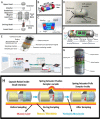Smart capsules for sensing and sampling the gut: status, challenges and prospects
- PMID: 37734912
- PMCID: PMC10715516
- DOI: 10.1136/gutjnl-2023-329614
Smart capsules for sensing and sampling the gut: status, challenges and prospects
Abstract
Smart capsules are developing at a tremendous pace with a promise to become effective clinical tools for the diagnosis and monitoring of gut health. This field emerged in the early 2000s with a successful translation of an endoscopic capsule from laboratory prototype to a commercially viable clinical device. Recently, this field has accelerated and expanded into various domains beyond imaging, including the measurement of gut physiological parameters such as temperature, pH, pressure and gas sensing, and the development of sampling devices for better insight into gut health. In this review, the status of smart capsules for sensing gut parameters is presented to provide a broad picture of these state-of-the-art devices while focusing on the technical and clinical challenges the devices need to overcome to realise their value in clinical settings. Smart capsules are developed to perform sensing operations throughout the length of the gut to better understand the body's response under various conditions. Furthermore, the prospects of such sensing devices are discussed that might help readers, especially health practitioners, to adapt to this inevitable transformation in healthcare. As a compliment to gut sensing smart capsules, significant amount of effort has been put into the development of robotic capsules to collect tissue biopsy and gut microbiota samples to perform in-depth analysis after capsule retrieval which will be a game changer for gut health diagnosis, and this advancement is also covered in this review. The expansion of smart capsules to robotic capsules for gut microbiota collection has opened new avenues for research with a great promise to revolutionise human health diagnosis, monitoring and intervention.
Keywords: colonic microflora; enteric bacterial microflora; gastrointesinal endoscopy; intestinal bacteria; small intestine.
© Author(s) (or their employer(s)) 2024. Re-use permitted under CC BY-NC. No commercial re-use. See rights and permissions. Published by BMJ.
Conflict of interest statement
Competing interests: None declared.
Figures







Similar articles
-
A smart capsule with a bacteria- and pH-triggered enteric polymer coating for targeted colonic microbiome sampling.Acta Biomater. 2025 Jun 1;199:412-427. doi: 10.1016/j.actbio.2025.04.025. Epub 2025 Apr 22. Acta Biomater. 2025. PMID: 40263059
-
Smart capsule for targeted proximal colon microbiome sampling.Acta Biomater. 2022 Dec;154:83-96. doi: 10.1016/j.actbio.2022.09.050. Epub 2022 Sep 24. Acta Biomater. 2022. PMID: 36162763 Free PMC article.
-
Capsules for the Diagnosis and Treatment of Gastrointestinal Motility Disorders- A Game Changer.Curr Gastroenterol Rep. 2024 Jun;26(6):157-165. doi: 10.1007/s11894-024-00926-8. Epub 2024 Apr 17. Curr Gastroenterol Rep. 2024. PMID: 38630422 Review.
-
A review of localization systems for robotic endoscopic capsules.IEEE Trans Biomed Eng. 2012 Sep;59(9):2387-99. doi: 10.1109/TBME.2012.2201715. Epub 2012 Jun 18. IEEE Trans Biomed Eng. 2012. PMID: 22736628 Review.
-
Magnetic robotic manoeuvring of gastrointestinal video capsules: preliminary phantom tests.Biomed Pharmacother. 2008 Oct;62(8):546-9. doi: 10.1016/j.biopha.2008.07.057. Epub 2008 Aug 6. Biomed Pharmacother. 2008. PMID: 18786802
Cited by
-
Gut-Heart Axis: The Role of Gut Microbiota and Metabolites in Heart Failure.Circ Res. 2025 May 23;136(11):1382-1406. doi: 10.1161/CIRCRESAHA.125.325516. Epub 2025 May 22. Circ Res. 2025. PMID: 40403109 Review.
-
The gut microbiome in disorders of gut-brain interaction.Gut Microbes. 2024 Jan-Dec;16(1):2360233. doi: 10.1080/19490976.2024.2360233. Epub 2024 Jul 1. Gut Microbes. 2024. PMID: 38949979 Free PMC article. Review.
-
Untargeted and semi-targeted metabolomics approach for profiling small intestinal and fecal metabolome using high-resolution mass spectrometry.Metabolomics. 2025 Jun 19;21(4):84. doi: 10.1007/s11306-025-02288-2. Metabolomics. 2025. PMID: 40537703 Clinical Trial.
-
Classifying compounds as prebiotics - scientific perspectives and recommendations.Nat Rev Gastroenterol Hepatol. 2025 Jan;22(1):54-70. doi: 10.1038/s41575-024-00981-6. Epub 2024 Oct 2. Nat Rev Gastroenterol Hepatol. 2025. PMID: 39358591 Review.
-
Microbiota-Gut-Brain Axis in Psychiatry: Focus on Depressive Disorders.Curr Epidemiol Rep. 2024 Dec;11(4):222-232. doi: 10.1007/s40471-024-00349-z. Epub 2024 Jun 5. Curr Epidemiol Rep. 2024. PMID: 40130013 Free PMC article.
References
-
- Mackay RS. Radio telemetering from within the human body. IRE Trans Med Electron 1959;ME-6:100–5. 10.1109/IRET-ME.1959.5007926 - DOI
Publication types
MeSH terms
LinkOut - more resources
Full Text Sources
Medical
Research Materials
